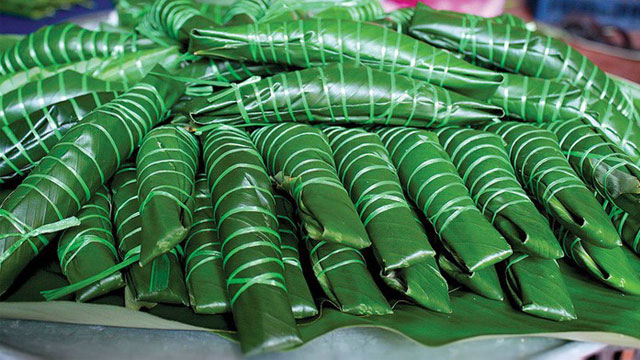Yen Bai is a highland province inhabited by many ethnic minorities. Ethnic diversity has contributed to creating a colorful culture for this place. Talking about diversity, cuisine is one of the most colorful “party”. For example, it is possible to mention the bird cake (cuckoo cuckoo) of the Dao people.
This strangely named cake comes from an accumulation of motherly love. People tell each other that Dao mothers go to the fields, but their hearts still ache for their little children at home. Then, in the afternoons, when they have free time, they arrange the pandan leaves in the forest into a cake . At home, they add flour to make beautiful cakes.
Today, bird cake is still wrapped with forest pandan leaves, but the cake is more elaborately prepared.
People mix more green beans or dye the rice with different types of leaves so that each cake is a different eye-catching. In fact, in addition to shaping the owl bird, people can knit into the shape of other things at will, but perhaps because of the old meaning, the image of the owl is still the most popular.
During the cake wrapping sessions, the Dao women would gather together in a corner of the house and then skillfully twist it so that it looks the most like a owl. But also make sure that the cake is small and beautiful, not too big and not too long. The small cake is neatly folded and cooked in a pot full of water for about 1 hour, it is already enjoyed by the body.
Giving each other a woof cake is like giving each other delicious food when hungry. And with these little babies, it is also the love of their mothers for them. This rustic dish is indispensable in the holidays. Absence of the woof cake seems to make the taste of the mountains and forests lose a few parts already.
Source: Collected internet.
Vietnam is located in the Indomalaya ecological region. According to the 2005 National Environmental Status Report, Vietnam is among the 25 countries with high levels of biodiversity, ranked 16th worldwide in terms of biodiversity and is home to about 16% of the world's biodiversity. species in the world. 15,986 plant species have been found throughout the country, of which 10% are endemic. Vietnam has 307 species of nematodes, 200 species of oligochaeta, 145 species of acarina, 113 species of springtails, 7,750 species of insects, 260 species of reptiles. , 120 species of amphibians, 840 species of birds and 310 species of mammals, of which 100 species of birds and 78 species of mammals are endemic. There are also 1,438 species of freshwater algae, accounting for 9.6% of the total number of algae species, as well as 794 species of aquatic invertebrates and 2,458 species of marine fish. In the late 1980s, a population of Javan Rhinos was discovered in Cat Tien National Park and it is possible that the last individual of this species in Vietnam died in 2010.
Costume is one of the important factors that differentiate Vietnamese culture from other countries in the world. The costumes not only mark the cultural traditions and customs of the Vietnamese people, but they are also the breath and soul of a nation.
Folk theater has many forms and has existed for a long time such as Cheo singing, Tuong singing, water puppetry... and newer ones such as Cai Luong, folk opera. Cheo is a form of theatrical storytelling, using the stage and actors as a means of interacting with the public. The content of Cheo plays is taken from fairy tales and Nom stories, carrying profound realistic and ideological values, while also expressing Vietnamese ethnicity. Cheo stage is simple, with non-professional actors performing impromptu...
As a province in the Southeast region, Binh Phuoc is known for its pristine and idyllic beauty. In recent years, Binh Phuoc is emerging as an interesting place to visit and explore for domestic and foreign tourists.
